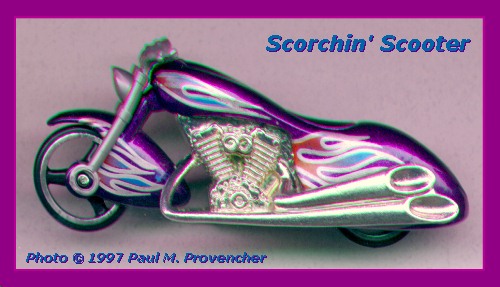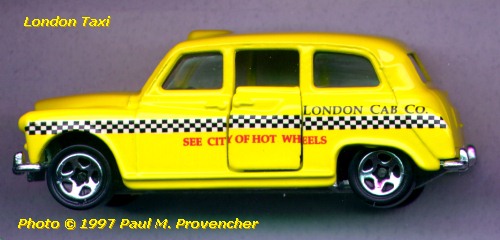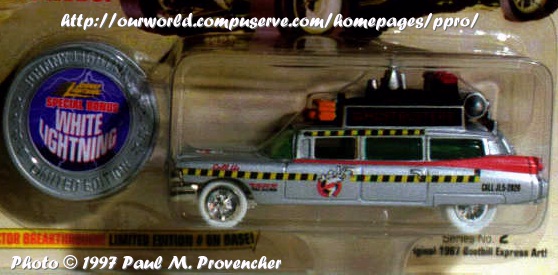Toy Trader
Die Cast Insider - March 1998
© 1998 Paul M. Provencher |
 |
1/64th Scale Die
Cast Ramblings
The last few years have been good for collectors of small scale die cast. They
have also been difficult. We have seen the level of interest in collecting skyrocket and
the competition for new items grow in kind. In the late 80's, there was nowhere near the
number of choices. For mass-market, retail die cast subjects, the choices were fairly
straight forward. Hot Wheels, Matchbox, Majorette, Corgi,
Dinky. They all had standard lines and few if any limited editions. Collectors complained
that there were not enough subjects. Over the next few years, more variations and new
brands appeared. Collectors, car lovers and gift-givers found lots more to choose from.
Playing Mantis surfaced with the repro-Johnny
Lightning line. Mattel released their 25th Anniversary and Vintage repro's. More Hot
Wheels series cars were developed and introduced. There were unending series of Johnny
Lightning Muscle Cars. Matchbox nearly disappeared. Corgi came close too.
"Limited
Editions"
Then there was the start of the randomly distributed "limited editions". Johnny Lightning White
Lightning, Hot Wheels Treasure Hunts, Matchbox
Challenge and Racing Champions Chase cars. If any one thing can be credited with
having the most impact on the collecting of die cast vehicles, these so-called rare items
and the attendant marketing hype deserves the prize. While nothing can equal the thrill of
finding one of these items on the shelf in a retail store, the problems that arose because
of them have changed the hobby.
I got interested in Hot Wheels again because of the classic cars (Packard, Duesenberg,
Talbot Lago, et al). From there, I got interested in the collector numbers. They are
pretty easy to find, generally pretty consistent quality, and quite durable. As a pure
collectible, Hot Wheels do not likely offer the best return on investment - the current
flood of cars from Mattel pretty well assures that most, if not all Hot Wheels will be
pretty abundant for years to come. I often find last years hot stuff on the pegs in stores
with flea market stickers still on them. To me, this is a sure sign that the price in the
secondary market on these items has run its course. Over-anxious collectors who have paid
ten times the retail price for a piece such as this eventually find that the purchase
never yields a dividend, and perhaps that friendly "dealer" was not really such
a big help after all.
In January of 1995, when the first Treasure Hunts starting shipping to stores, they were
relatively unknown and fairly easy to find. At the time, I thought that it would be easy
enough to find them all in the normal course of shopping. But by March of the same year,
they were so widely publicized that it is unlikely that the majority ever made it to the
shelves. People who never collected toy cars got attracted to them because of the easy
income that could be generated by selling them at shows. At the Hot Wheels Convention in
October 1997, the Mattel representative announced that there would be Treasure Hunts for
1998. The crowd booed. I have heard stories about things that have happened in stores that
are amazing, with Treasure Hunt cars being the root cause.
For example, a friend in San Diego California was shopping in a discount toy store and
found a Treasure Hunt. As she stood there admiring her find, an aggressive young man
walked up, grabbed it out of her hands and ran away. Last week, I received a report from a
reliable source that a friend of his saw a Treasure Hunt hanging on a peg, reached for it,
and was stabbed in the back of the neck by another customer who apparently thought that
this attack would be necessary to get the car. One of them went to the hospital and the
other to the police station. Neither of them got the Treasure Hunt. I have been shopping,
found Treasure Hunts, and then run into someone who insists that since I already have one,
that the one in my hand belongs to them... I have watched grown adults tear apart displays
looking for them and leave the mess behind for someone else to pick up.
In my opinion these "limited edition" and "random insert" marketing
tactics create a false impression of rarity and have attracted a bad element to the hobby.
And unfortunately, many collectors think they have no choice but to buy these pieces from
scalpers or go without. For the lucky few who have friends to trade with or live in an
area where interest is not so out of control, life is much simpler. I refuse to pay
scalper prices for items like the Treasure Hunt series cars. I do not consider them
limited editions, have not seen many that I could not live without, and have a fundamental
problem with paying someone 10 or 20 times the retail value for something like an 89 cent
car that left the factory two months ago.
One might think that in consequence, I do not have very many of these type of cars. But in
fact, I have completed Treasure Hunt series for 1996 and have come close to finishing 1997
without having to pay scalper prices. I still have a few left to acquire for 1995, but
time is on my side. I doubt that the prevailing market price of these items will ever
exceed what scalpers were selling them for when they first came out. I recommend that you
try to find them in stores, trade them with people who feel the same way, and generally
take your time. With somewhere between 10,000 and 25,000 Treasure Hunts made, I think that
the ones you are missing will find their way to you in due course.

Too Many Cars?
Today there are lots more vehicles to choose from. So many in fact that some wonder where
it stops. I will confess that I was swept up in the concept of collecting whole series of
cars. I do my own shopping and have put some miles on my sneakers trying to get the
complete sets. For example, from 1985 to the present, I have tried to get every Hot Wheels
subject produced. In the last year that has become a daunting and expensive proposition.
In the series cars and Treasure Hunt lines alone, Mattel made 72 different cars, many in
more than one variation. Mattel is also in the third year of producing Hot Wheels
Collectibles for the Adult collector. These sets typically sell for between $20 and $50
for as few as two cars and as many as four. The Collectible line is a much nicer product
and merits a higher price, but is no longer cheap to collect. Then there is the regular
line of collector numbered Hot Wheels. There were approximately 200 new variations
released last year alone! If you were to buy one of every car in the Hot Wheels line last
year, you would have spent at least $500 (retail prices). And that does not take into
account the Limited Editions that are sold by legitimate dealers, and the flood of
promotional items that are offered by various food companies.
Corgi made a reappearance in 1995 with the Mattel logo adorning the Auto City line. Mattel
revised the bases of the cars, adding their trademark, developed new tampo designs and
colors, and began integrating the Corgi castings into the regular Hot Wheels line. The FAO
Schwarz set of black cars with gold accents were all Corgi Castings. The Corgi castings
also appeared in the international market on new Hot Wheels packaging. Next these cars
were folded in to play sets and special purchase items, such as the Target sets released
for the Holidays in 1996. Most recently, these Corgi castings have started appearing in
single blisters as part of the regular Hot Wheels "Collector Number" line. Most
cars have been made in China and feature a new "form fitting" blister package. I
welcome the return of the Corgi castings and look forward to seeing what Mattel is doing
with them! One thing that is good is the use of the Hot Wheels wheel in lieu of the rather
unattractive Corgi wheels.
I have managed to avoid getting too obsessed with Matchbox. I have always stuck to
"buy what you like" with Matchbox and have managed to keep it that way. I got
many of the Premiere series sets, but eventually tired of the variations. I got the
Inaugural Series cars up to the point where the line was discontinued. I have bought
several of the new 1997 castings. I have less that 100 "new" Matchbox cars and
feel they are items that I would buy again. It was only recently that I was able to find a
Matchbox Challenge car in the store. I treasure the few vintage Matchbox cars that I have
and really think that I may get more actively involved with getting the old Lesney
castings that were current when I was a kid.
Matchbox has started producing some subjects that are easier on the eyes of adults. The
recent release of the Viper GTS, Alpha Romeo, Chrysler Atlantic, '56 Ford Pickup, to name
but a few, shows that Matchbox is not gone by a long shot. And lest anyone be quick to
attribute the turn around to Mattel, it should be noted that the folks representing Mattel
at the Hot Wheels convention (designers) made the comment that "...Matchbox does
their own thing. " I am happy to hear that. I can remember being disappointed with
Lesney when Superfast wheels were put onto Matchbox toys. Ironically, it is the new wheel
on the new Matchbox offerings that I like best about them. I dislike the
"spiral" wheel that has been on Matchbox cars forever. The first time I saw the
new wheel style, I knew there was hope yet for Matchbox.

I have not been buying many
Johnny Lightning cars lately. This is in part due to the fact that I am not really a big
Muscle Car fan and I am not really a big lover of fantasy cars and Funny Cars. Another
reason that I cut back my Johnny Lightning collecting was price. They are considerably
more expensive than other cars of the same size and often are not as nicely finished. The
biggest problem with many Johnny Lightning vehicles is the poor appearance of the tires
and wheels in relation to the size of the casting. And after 12 different variations of
the same casting, some in hideous colors, I started to realize that I was collecting these
cars not because I liked them but because I somehow thought I needed to get them all. At
one point it threatened to become a full-time activity. And here again, these vehicles,
with few exceptions, are not rare. With the exception of the first White Lightning series
(1400 each of eight castings), the Muscle Cars (first edition) Series 2 Boss 302 with a
casting error (1600 made before the casting was changed), a Ghostbusters White Lightning
(200 made) and a few others, each person in a city of 20,000 people could have their own
complete collection of Johnny Lightnings. And even though some of them are rare, they are
not cars that I would normally admire. I have also learned that many Johnny Lightning cars
are put on clearance sale after a few months. This can represent a saving of as much as
75% off the original retail price. Granted, the popular ones will not make it to
clearance, but for the collector of "everything they made", this can be a real
bonus.
Of all the series that Playing Mantis are running, I find the Hot Rods series to be the
most interesting. There are a host of unique subjects that are not being done ad naseaum
everywhere else. The colors are a bit uneven, but once again, collecting just what you
like, there is sure to be a color sooner or later that works for you. I must voice the
same criticism about the wheels. There are some nice subjects in the Hot Rod line that are
let down by the badly scaled and poorly positioned wheels and tires.
Paul M. Provencher

Click here to see a selection of
Die Cast Collector books from Amazon.com
|



